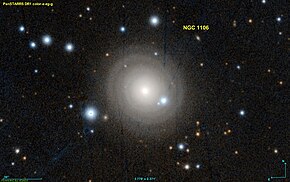

 02h50m40.51s, +41° 40′ 17.4″
02h50m40.51s, +41° 40′ 17.4″| NGC 1106 | |
|---|---|
 | |
| Observation data (J2000 epoch) | |
| Right ascension | 02h50m 40.51s[1] |
| Declination | +41° 40′ 17.4″[1] |
| Redshift | 0.014467 ± 0.000063[1] |
| Heliocentric radial velocity | 4337 ± 19 km/s[1] |
| Distance | ~199 ± 14 · 106 Mly[1] (61.0 ± 4.3 Mpc) |
| Apparent magnitude (V) | 12.5[1] |
| Apparent magnitude (B) | 13.5[1] |
| Surface brightness | 12.7 mag/arcmin2[1] |
| Characteristics | |
| Apparent size (V) | 1.30 x 1.0 arcmin[1] |
| Other designations | |
| UGC 2322, MCG 7-6-76, ZWG 539.112, PGC 10792, IRAS 02474+4127 | |
NGC 1106 is a lenticular, non-barred spiral galaxy with considerable structure (type SA0^+), located in the Perseus constellation.[1][2] It was first observed by astronomer John Herschel in 1828.[3]
In 2016, astronomers confirmed NGC 1106 contains a Compton-thick[4] active galactic nucleus, after extensive analysis of the galaxy's X-ray spectra.[5] Due to the AGN in its center, it's also classified as a type II Seyfert galaxy, meaning it has the characteristic bright core of a Seyfert galaxy, as well as appearing bright when viewed at infrared wavelengths.
A study released in 2022 detected active star formation in NGC 1106.[6] The research involved the use of far-ultraviolet and mid-infrared analysis, both techniques are extensively used as star formation rate tracers.[7]
Other Seyfert galaxies include:
|
| |||||||||||||
|---|---|---|---|---|---|---|---|---|---|---|---|---|---|
| |||||||||||||
| Stars |
| ||||||||||||
| |||||||||||||
| Star clusters |
| ||||||||||||
| Nebulae |
| ||||||||||||
| Galaxies |
| ||||||||||||
| |||||||||||||
| |||||||||||||